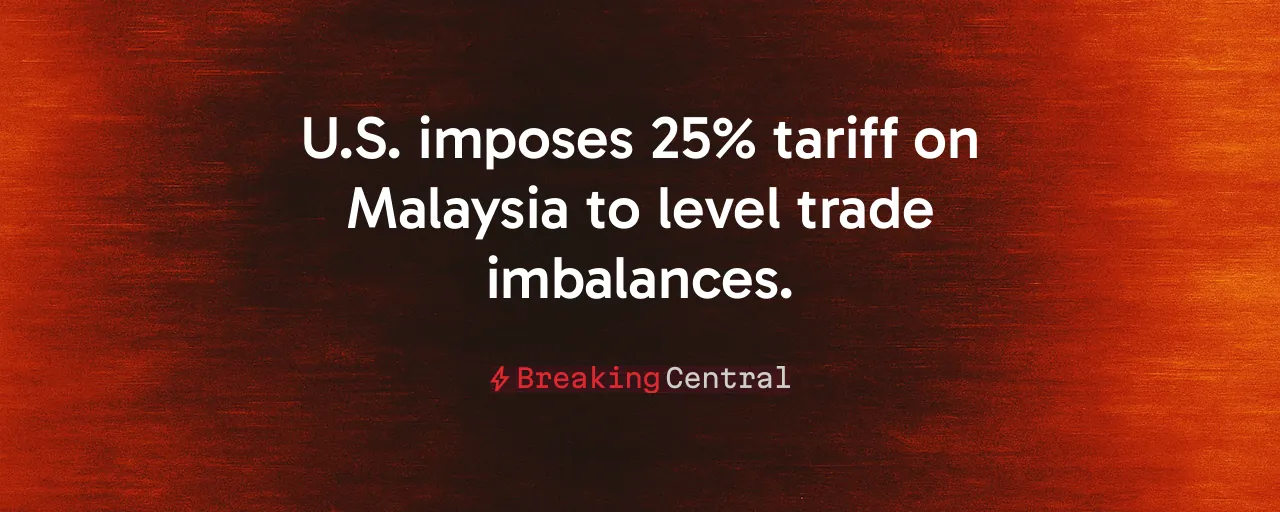A Bold Move to Level the Playing Field
The United States sent shockwaves through global trade on July 8, 2025, when Malaysia's trade ministry clarified that a new 25 percent levy on its exports, effective August 1, would replace the existing 10 percent tariff. This policy, rooted in President Trump's reciprocal tariff program, targets nations with persistent trade surpluses. Malaysia, a key player in electronics and palm oil, now faces a pivotal moment. The decision underscores a broader effort to correct economic imbalances and prioritize American workers.
For years, the U.S. has grappled with a trade deficit with Malaysia, reaching $16 billion in 2024. This gap, driven by imports of semiconductors and commodities, drains American wealth. The tariff hike aims to incentivize domestic production and protect industries vital to national security. While some fear higher consumer prices, supporters argue the move strengthens the economy by bringing supply chains home.
The White House's executive order, issued in June 2025, set the stage for this shift. It raised tariffs on 14 nations, including Malaysia, unless bilateral talks resolve market-access issues by August. Malaysia's initial confusion, with a minister claiming a 35 percent cumulative rate, sparked alarm. Swift corrections by Reuters and Malaysia's trade ministry clarified the 25 percent cap, but the stakes remain high.
Protecting American Jobs and Security
The tariff addresses a core issue: Malaysia's trade practices tilt the scales. Its localization rules and stringent halal certification requirements often lock out American exporters. These barriers, coupled with a $16 billion trade surplus, justify reciprocal action. The U.S. seeks fairness, demanding Malaysia open its markets and strengthen intellectual property protections.
National security also drives the policy. Malaysia dominates back-end semiconductor assembly, a critical component for defense electronics. Relying on foreign supply chains risks vulnerabilities, especially amid geopolitical tensions. By raising tariffs, the U.S. encourages firms to relocate production domestically or to allied nations, reducing dependence on distant hubs.
Historical precedent supports this approach. In 2018, Section 232 tariffs on steel and aluminum pressured trading partners to negotiate better terms. Malaysia secured minor exemptions then, but today's broader trade imbalances demand stronger measures. The 2024 deficit underscores the need for action to safeguard American industries.
Risks and Realities of Tariff Pressure
Critics warn the tariff could backfire. The Peterson Institute estimates it may shave 0.4 percentage points off Malaysia's 2025 GDP while nudging U.S. goods inflation up by 0.05 points. American consumers, particularly low-income shoppers, may face higher prices for electronics and palm-oil-based goods. Retailers reliant on Malaysian inputs could pass costs along, squeezing household budgets.
Malaysia's response adds complexity. Its exporters, from rubber glove makers to electronics firms, face margin pressures. Up to 30,000 jobs in Malaysia's export zones hang in the balance. Some fear Malaysia might retaliate, targeting U.S. agricultural exports like soybeans. Yet, the U.S. holds leverage: Malaysia's economy depends heavily on American markets.
Another concern is transshipment. Malaysia could become a conduit for Chinese goods dodging U.S. duties. Robust customs enforcement, including origin verification, will be critical. The tariff's success hinges on preventing such loopholes while maintaining pressure for fairer trade terms.
A Strategic Path to Economic Strength
The tariff's true aim transcends short-term revenue, projected at $11 billion over three years. It signals a commitment to rebalancing global trade. Malaysia needs to lower its own tariffs and ease procurement restrictions, particularly in medical technology, to avoid prolonged duties. Targeted exemptions for firms relocating to the U.S. could sweeten negotiations, aligning with America's onshoring goals.
Compromise remains possible. Tariff-rate quotas for sensitive sectors such as palm-oil biodiesel and finished rubber goods could soften the blow for Malaysia while preserving U.S. leverage. Joint mechanisms to block Chinese transshipment would address shared concerns. Time-bound waivers for critical semiconductors and renewable-energy components could protect shared strategic interests without abandoning the principle of reciprocity.
The August 1 deadline looms as a test of resolve. Malaysia's role in the Indo-Pacific Economic Framework offers a platform for talks, but the U.S. needs to stand firm. Decades of trade liberalization, from APEC in the 1990s to failed FTA talks in 2005, show concessions without reciprocity yield little. Firmness now could secure lasting economic gains.
Building a Resilient Future
America's tariff on Malaysia reflects a broader vision: an economy that prioritizes its workers and security. By addressing trade imbalances, the policy fosters resilience in critical industries. It challenges Malaysia to compete fairly, benefiting both nations through transparent, reciprocal trade.
The road ahead requires vigilance. Enforcing tariffs, monitoring transshipment, and negotiating exemptions demand precision. American consumers may feel short-term pain, but the long-term payoff, stronger industries, secure supply chains, and fairer trade, outweighs the costs. This moment tests whether the U.S. can lead with strength.
As talks unfold, the tariff stands as a reminder: economic fairness is non-negotiable. Malaysia, a valued partner, has a chance to align with open markets. The U.S., by holding the line, charts a course toward prosperity rooted in self-reliance and mutual respect.
